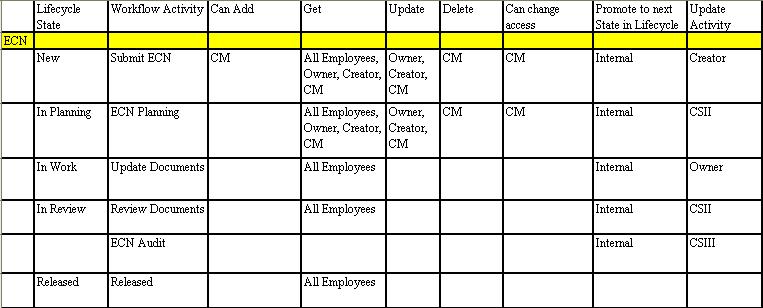
The ECN
The ECN is a process by which the changes are implemented within an organization. There are three types of changes that can take place: 1. a part or document can be added; 2. a part or document can be changed; 3. a part or document can be deleted. When a new part is added the ECN process is used to take the part from its Preliminary state, to a Released State. When a part is changed or deleted, the ECN takes it from the Released state to the Superseded state. Let's take a look at the Life Cycle Map of a part, while keeping in mind that this process occurs automatically as the Part is created, reviewed, or changed through an ECN:

Below is the work flow map of an ECN:

The ECN is typically initiated by a member of the CM group. One of the change specialists fills out the required information, attaches the ECRs and the files necessary for the ECN review, and then submits the ECN. During the ECN Planning activity, the CSII reviews the information and makes decisions about the propagation of the change up the parts assembly line. For example, every company has its own rules dealing with the conditions under which a part receives a new revision or maybe an entirely new part number. Also, the parent parts, or the containing assemblies, may require a change of revision or part number. The CSII would consider all of these changes and make decisions and recommendations. The CSII also assigns an Owner to this ECN, who is the engineer or the technical person responsible for the technical implications of the change and its ramifications. The ECN is then transferred to the Owner during the Update Documents activity. The Owner is responsible for updating the BOMs, specifications, drawings, and any other specified documents affected by this change. The affected parts requiring the change of documents may be not only the parts being changed directly, but also the parent parts or the containing assemblies. The ECN is then transferred back to the CSII who reviews the documents during the Review Documents activity. The CSII can then either reject of approve the ECN. On approval, the ECN advances to ECN Audit. After the audit is completed the ECN is released, which also automatically updates the life cycle state of the affected Parts and Documents. Here is a table summary of the workflow activities and life cycle states of the ECN:

The ECN report is available to display a printable version of the ECN form. This report is available as a menu choice from the main menu bar.